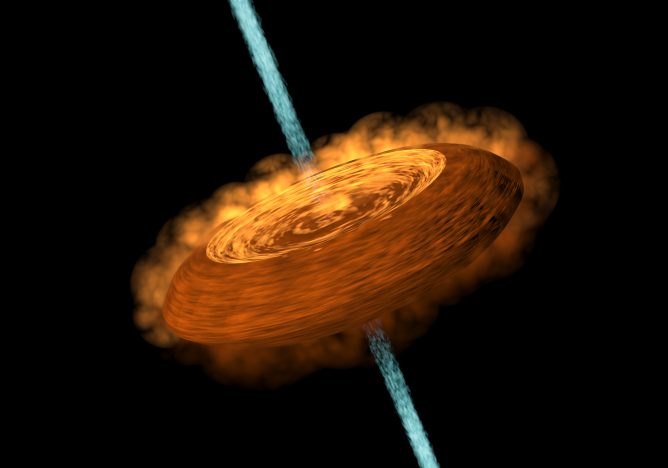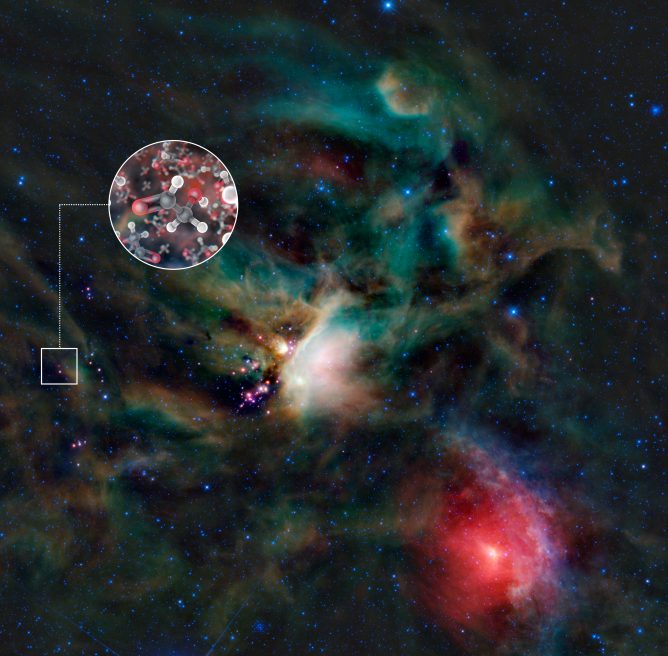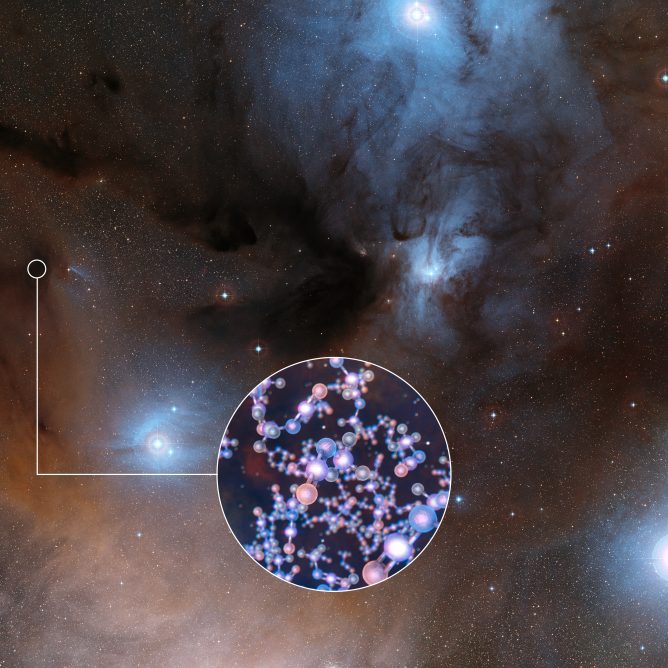An international research team, led by Chin-Fei Lee of the Academia Sinica Institute of Astronomy and Astrophysics (ASIAA, Taiwan), has used the Atacama Large Millimeter/submillimeter Array (ALMA) and made two surprising discoveries around a very young protostar HH212. They imaged the distribution of complex organic molecules around the protostar and found the gas jet emanated from the protostar is rotating.
Herbig-Haro (HH) 212 is a nearby protostellar system in Orion at a distance of about 1,300 light-years. The central protostar is very young, with an estimated age of only 40,000 years — about 1/100,000th the age of our Sun — and a mass of only 0.2 solar mass. It drives a powerful bipolar jet and thus must accrete material efficiently. Indeed, an accretion disk is seen feeding the protostar. The disk is nearly edge-on and has a radius of about 60 astronomical units (au), or 60 times the average Earth-Sun distance. Interestingly, it shows a prominent equatorial dark lane sandwiched between two brighter features, looking like a “space hamburger.” [1]
Imaging the distribution of complex organic molecules
The research team’s ALMA observations have clearly detected an atmosphere of complex organic molecules above and below the disk [2] . These include methanol (CH3OH), deuterated methanol (CH2DOH), methanethiol (CH3SH), and formamide (NH2CHO). These molecules have been proposed to be the precursors for producing biomolecules such as amino acids and sugars. “They are likely formed on icy grains in the disk and then released into the gas phase because of heating from stellar radiation or some other means, such as shocks,” says co-author Zhi-Yun Li of the University of Virginia.
Jet, disk, and disk atmosphere in the HH 212 protostellar system. (a) A composite image for the HH 212 jet in different molecules, combining the images from the Very Large Telescope (McCaughrean et al. 2002) and ALMA (Lee et al. 2015). Orange image shows the dusty envelope+disk mapped with ALMA. (b) A zoom-in to the central dusty disk. The asterisk marks the position of the protostar. A size scale of our solar system is shown in the lower right corner for comparison. (c) Atmosphere of the accretion disk detected with ALMA. In the disk atmosphere, green is for deuterated methanol, blue for methanethiol, and red for formamide.
Credit: ALMA (ESO/NAOJ/NRAO)/Lee et al.
“It is so exciting to discover complex organic molecules on an accretion disk around a baby star,” says Chin-Fei Lee at ASIAA. “When such molecules were first found in the protoplanetary disk around a star in a later phase of star formation, we wondered if they could have formed earlier. Now, using ALMA’s unprecedented combination of spatial resolution and sensitivity, we not only detect them on a younger accretion disk, but also determine their location. These molecules are the building blocks of life, and they are already there in the disk atmosphere around the baby star in the earliest phase of star formation.”
These molecules play a crucial role in producing the rich organic chemistry needed for life. The discovery suggests that the building blocks of life are produced in such disks at the very beginning of star formation and that they are available to be incorporated into planets that form in the disk subsequently. It could help us understand how life came to be on Earth.
Imaging the rotation of the jets
Protostellar jets are seen coming out from protostars, representing one of the most intriguing signposts of star formation. The team has made a new breakthrough observation with ALMA, finding a protostellar jet to be spinning, convincingly for the first time [3] .
“We see jets coming out from most of baby stars, like a train of bullets speeding down along the rotational axis of the accretion disks. We always wonder what their role is. Are they spinning, as expected in current models of jet launching? However, since the jets are very narrow and their spinning motion is very small, we had not been able to confirm their spinning motion. Now using the ALMA with its unprecedented combination of spatial and velocity resolutions, we not only resolve a jet near a protostar down to 10 AU but also detect its spinning motion”, says Chin-Fei Lee at ASIAA. “It looks like a baby star spits a spinning bullet each time it takes a bite of a space hamburger.”
“The central problem in forming a star is the angular momentum in the accretion disk which prevents material from falling into the central protostar. Now with the jet carrying away the excess angular momentum from the material in the innermost region of the disk, the material can readily fall into the central protostar from the disk”, says Paul Ho at ASIAA.
Previous observations of HH212 at a spatial resolution of 140 au could not confirm a rotation for the jet. Now with ALMA at a resolution of 8 au, which is about 17 times higher, we zoom in to the innermost part of the jet down to within 10 au of the central protostar and find a jet rotation. The angular momentum is so small that the jet has to be launched from the innermost region of the disk at about 0.05 au from the central protostar, well consistent with current models of the jet launching.
This new finding indicates that the jet indeed carries away part of the angular momentum (rotational momentum) from the material in the innermost region of the accretion disk (space hamburger), which is rotating around the central protostar. This reduces the rotation of the material there, allowing the disk to feed the central protostar.
Jet and disk in the HH 212 protostellar system: (a) Molecular jet (green image) ejected from the innermost part of the accretion disk (orange image), observed with ALMA at a resolution of 8 AU. A dark lane is seen in the disk equator, causing the disk to appear as a “hamburger”. A size scale of our solar system is shown in the lower right corner for size comparison. (b) Split of the redshifted (turning away from us) and blueshifted (turning toward us) emission of the jet in order to show the spinning motion of the jet, as indicated by the green arrows. Blue and red arrows show the rotation of the disk, which has a direction the same as the jet rotation.
Credit: ALMA (ESO/NAOJ/NRAO)/Lee et al.
Paper and research team
The research result on protostellar jet were published as Lee et al. “A rotating protostellar jet launched from the innermost disk of HH 212” in Nature Astronomy on June 12, 2017.
The research result on complex organic molecules were published as Lee et al. “Formation and Atmosphere of Complex Organic Molecules of the HH 212 Protostellar Disk” in the Astrophysical Journal on July 1, 2017.
The research team members are:
Chin-Fei Lee (ASIAA) Zhi-Yun Li (University of Virginia), Paul T. P. Ho (East Asia Observatory/ASIAA), Naomi Hirano (ASIAA), Qizhou Zhanb (Harvard-Smithsonian Center for Astrophysics), Hsien Shang (ASIAA)
| 1 | The team led by Chin-Fei Lee observed HH212 with ALMA and found the Hamburger-like dusty disk. |
|---|---|
| 2 | ALMA has found complex organic molecules around a protostar IRAS 16293-2422. See “Sweet Result from ALMA – Building blocks of life found around young star” and ”ALMA Finds Ingredient of Life Around Infant Sun-like Stars.” |
| 3 | A research team led by Tomoya Hirota at the National Astronomical Observatory of Japan obtained clear evidence of rotation in the gas outflow from a massive baby star Orion KL Source I with ALMA. Combining two results, gas jets and outflows have a crucial role in removing the rotational momentum both in low-mass and high-mass star formation processes. |










